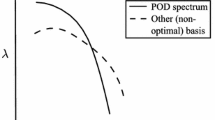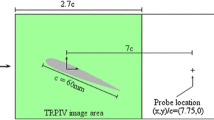Abstract
Low signal-to-noise in particle image velocimetry (PIV) measurements in systems such as high pressure gas turbine combustors can result in significant data gaps that negatively affect subsequent analysis. Here, gappy proper orthogonal decomposition (GPOD) is evaluated as a method of filling such missing data. Four GPOD methods are studied, including a new method that utilizes a median filter (MF) to adaptively select whether a local missing data point is updated after each iteration. These methods also are compared against local Kriging interpolation. The GPOD methods are tested using PIV data without missing vectors that were obtained in atmospheric pressure swirl flames. Parameters studied include the turbulence intensity, amount of missing data, and the amount of noise in the valid data. Two criteria to check for GPOD convergence also were investigated. The MF method filled in the missing data with the lowest error across all parameters tested, with approximately one-third the computational cost of Kriging. Furthermore, the accuracy of MF GPOD was relatively insensitive to the quality of the convergence criterion. Therefore, compared to the three other GPOD methods and Kriging interpolation, the MF GPOD method is an effective method for filling missing data in PIV measurements in the studied gas turbine combustor flows.








Similar content being viewed by others
Abbreviations
- N :
-
Total number of snapshots in a data set
- P :
-
Number of POD/GPOD modes
- \(a_{i}, b_{i}\) :
-
POD temporal coefficients
- \(\phi _{{i}}\) :
-
POD spatial eigenmodes
- \(\varvec{R}\) :
-
Correlation matrix
- \(\lambda _{n,j,i}\) :
-
POD eigenvalues
- \(\mathbf {u}\) :
-
Velocity
- \(\bar{\xi }_{n,j}\) :
-
Approximate filled field
- \(\breve{\bar{\xi }}_{n,j}\) :
-
POD approximation of field
- \(\hat{\xi }_{n}\) :
-
GPOD reconstructed field at the end of main iteration n (ES and Gunes methods)
- \(\hat{\hat{\xi }}_{n}\) :
-
GPOD reconstructed field at the end of main iteration n (FS and MF methods)
- \(\tilde{\xi }_{n,j}\) :
-
POD approximation of field using coefficients \(b_i\)
- \(F_{{s,n}}\) :
-
Field smoothness parameter (FS method)
- \(R_{n}\) :
-
Residual parameter for the Median Filter method
- \(\varepsilon\) :
-
Convergence tolerance for sub iterations
- E :
-
Reconstruction error over entire data set
- \(\psi\) :
-
Reconstruction error over a single snapshot
- \(K_{P_{n}}\) :
-
Kinetic energy calculated from POD eigenvalues of main iteration n
- \(K_{P_0}\) :
-
Kinetic energy calculated from POD eigenvalues of initial guess
- G :
-
Gappiness percentage
- q :
-
Turbulent kinetic energy calculated at center of jet
- \(\dot{m}_A\) :
-
Air flow rate (g/min)
- \(\dot{m}_{\mathrm{CH}_4}\) :
-
Fuel flow rate (g/min)
- \(P_\mathrm{th}\) :
-
Thermal power (kW)
- \(P^*\) :
-
Main iteration (GPOD mode) at which \(E = E^*\)
- \(E^*\) :
-
Minimum reconstruction error
- \(V_{\mathrm{mag}}\) :
-
Velocity magnitude
- n:
-
GPOD main iteration
- j:
-
GPOD sub iteration
- d:
-
Valid data
- g:
-
‘Real’ gaps
- cc:
-
Convergence checking gaps
- i:
-
Index of POD modes
- cp:
-
Center point
- ad:
-
Points adjacent to center point cp
References
Arndt C, Severin M, Dem C, Stöhr M, Steinberg A, Meier W (2015) Experimental analysis of thermo-acoustic instabilities in a generic gas turbine combustor by phase-correlated PIV, chemiluminescence, and laser Raman scattering measurements. Exp Fluids 56:69
Boxx I, Slabaugh C, Kutne P, Lucht R, Meier W (2015) 3 khz piv/oh-plif measurements in a gas turbine combustor at elevated pressure. Proc Combus Inst 35:3793–3802
Caux-Brisebois V, Steinberg A, Arndt C, Meier W (2014) Thermo-acoustic velocity coupling in a swirl stabilized gas turbine model combustor. Combus Flame 161:3166–3180
Cosic B, Terhaar S, Moeck J, Paschereit C (2015) Response of a swirl-stabilized flame to simultaneous perturbations in equivalence ratio and velocity at high oscillation amplitudes. Combus Flame 162:1046–1062
Dem C, Stöhr M, Arndt C, Steinberg A, Meier W (2015) Experimental study of turbulence-chemistry interactions in perfectly and partially premixed confined swirl flames. Z. Phys. Chem. 229:569–595
Dhanuka S, Temme JE, Driscoll JF, Mongia HC (2009) Vortex-shedding and mixing layer effects on periodic flashback in a lean premixed prevaporized gas turbine combustor. Proc Combust Inst 32:2901–2908
Everson R, Sirovich L (1995) Karhunen–Loeve procedure for gappy data. J Opt Soc Am A Opt Image Sci 12(8):1657–1664
Franzelli B, Riber E, Gicquel L, Poinsot T (2012) Large eddy simulation of combustion instabilities in a lean partially premixed swirled flame. Combust Flame 159:621–637
Fureby C, Grinstein FF, Li G, Gutmark EJ (2007) An experimental and computational study of a multi-swirl gas turbine combustor. Proc Combust Inst 31:3107–3114
Gunes H, Sirisup S, Karniadakis GE (2006) Gappy data: to krig or not to krig? J Comput Phys 212(1):358–382
Huang Y, Yang V (2009) Dynamics and stability of lean-premixed swirl-stabilized combustion. Prog Energy Combust Sci 35(4):293–364
Knole M, Sattelmayaer T (2009) Interaction of heat release and vortex breakdown during flame flashback driven by combustion induced vortex breakdown. Exp Fluids 47:627–635
Liang Y, Lee H, Lim S, Lin W, Lee K, Wu C (2002) Proper orthogonal decomposition and its applications part I: theory. J Sound Vib 252(3):527–544
Littlejohn D, Cheng R (2007) Fuel effects on a low-swirl injector for lean premixed gas turbines. Proc Combust Inst 31:3155–3162
Lophaven SN, Nielsen HB, Søndergaard J (2002) Dace-a matlab kriging toolbox, version 2.0. Tech. rep
Meier W, Weigand P, Duan X, Giezendanner-Thoben R (2007) Detailed characterization of the dynamics of thermoacoustic pulsations in a lean premixed swirl flame. Combust Flame 150:2–23
Oberleithner K, Stöhr M, Im S, Arndt C, Steinberg A (2015) Formation and flame-induced suppression of the precessing vortex core in a swirl combustor: Experiments and linear stability analysis. Combust Flame 162:3100–3114
Oliver MA, Webster R (1990) Kriging: a method of interpolation for geographical information systems. Int J Geogr Inf Syst 4(3):313–332
Raben SG, Charonko JJ, Vlachos PP (2012) Adaptive gappy proper orthogonal decomposition for particle image velocimetry data reconstruction. Meas Sci Technol 23(2):025,303
Raffel M, Willert CE, Wereley ST, Kompenhans J (2007) Particle image velocimetry: a practical guide (experimental fluid mechanics). Springer, New York
Rokhlin V, Szlam A, Tygert M (2009) A randomized algorithm for principal component analysis. SIAM J Matrix Anal Appl 31(3):1100–1124
Sirovich L (1987) Turbulence and the dynamics of coherent structures. Part I: coherent structures. Q Appl Math 45(3):561–571
Steinberg A, Arndt C, Meier W (2013) Parametric study of vortex structures and their dynamics in swirl-stabilized combustion. Proc Combust Inst 34(2):3117–3125
Stopper U, Meier W, Sadanandan R, Stöhr M, Aigner M, Bulat B (2013) Experimental study of industrial gas turbine flames including quantification of pressure influence on flow field, fuel/air premixing and flame shape. Combust Flame 160:2103–2118
Syred N (2006) A review of oscillation mechanisms and the role of the precessing vortex core (PVC) in swirl combustion systems. Prog Energy Combust Sci 32:93–161
Temme J, Allison P, D JF (2014) Combustion instability of a lean premixed prevaporized gas turbine combustor studied using phase-averaged PIV. Combust Flame 161:958–970
Venturi D, Karniadakis GE (2004) Gappy data and reconstruction procedures for flow past a cylinder. J Fluid Mech 519:315–336
Westerweel J, Scarano F (2005) Universal outlier detection for PIV data. Exp Fluids 39(6):1096–1100
Wieneke B (2015) Piv uncertainty quantification from correlation statistics. Meas Sci Technol 26(7):074,002
Acknowledgments
This work was supported by NSERC Canada and GE under Grant CRDPJ 47740.
Author information
Authors and Affiliations
Corresponding author
Rights and permissions
About this article
Cite this article
Saini, P., Arndt, C.M. & Steinberg, A.M. Development and evaluation of gappy-POD as a data reconstruction technique for noisy PIV measurements in gas turbine combustors. Exp Fluids 57, 122 (2016). https://doi.org/10.1007/s00348-016-2208-7
Received:
Revised:
Accepted:
Published:
DOI: https://doi.org/10.1007/s00348-016-2208-7




